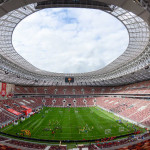By Dimitris Vlachos, George Varvitsiotis, Thommas Antonopoulos & Alexander Kepenos
Association football, more commonly known as football or soccer, is a team sport played with a spherical ball between two teams of eleven players. It is played by 250 million players in over 200 countries and dependencies, making it the world’s most popular sport. The game is played on a rectangular field called a pitch with a goal at each end. The object of the game is to score by moving the ball beyond the goal line into the opposing goal.
Association football is one of a family of football codes, which emerged from various ball games played worldwide since antiquity. The modern game traces its origins to 1863 when the Laws of the Game were originally codified in England by The Football Association.
Players are not allowed to touch the ball with hands or arms while it is in play, except for the goalkeepers within the penalty area. Other players mainly use their feet to strike or pass the ball, but may also use any other part of their body except the hands and the arms. The team that scores most goals by the end of the match wins. If the score is level at the end of the game, either a draw is declared or the game goes into extra time or a penalty shootout depending on the format of the competition. Association football is governed internationally by the International Federation of Association Football, which organises World Cups for both men and women every four years.
Association football is played in accordance with a set of rules known as the Laws of the Game. The game is played using a spherical ball of 68–70 cm circumference known as the football (or soccer ball). Two teams of eleven players each compete to get the ball into the other team’s goal (between the posts and under the bar), thereby scoring a goal. The team that has scored more goals at the end of the game is the winner; if both teams have scored an equal number of goals then the game is a draw. Each team is led by a captain who has only one official responsibility as mandated by the Laws of the Game: to represent his or her team in the coin toss prior to kick-off or penalty kicks.
The primary law is that players other than goalkeepers may not deliberately handle the ball with their hands or arms during play, though they must use both their hands during a throw-in restart. Although players usually use their feet to move the ball around they may use any part of their body (notably, «heading» with the forehead) other than their hands or arms. Within normal play, all players are free to play the ball in any direction and move throughout the pitch, though players may not pass to teammates who are in an offside position.
During gameplay, players attempt to create goal-scoring opportunities through individual control of the ball, such as by dribbling, passing the ball to a teammate, and by taking shots at the goal, which is guarded by the opposing goalkeeper. Opposing players may try to regain control of the ball by intercepting a pass or through tackling the opponent in possession of the ball; however, physical contact between opponents is restricted. Football is generally a free-flowing game, with play stopping only when the ball has left the field of play or when play is stopped by the referee for an infringement of the rules. After a stoppage, play recommences with a specified restart.
At a professional level, most matches produce only a few goals. For example, the 2005–06 season of the English Premier League produced an average of 2.48 goals per match. The Laws of the Game do not specify any player positions other than goalkeeper, but a number of specialised roles have evolved. Broadly, these include three main categories: strikers, or forwards, whose main task is to score goals; defenders, who specialise in preventing their opponents from scoring; and midfielders, who dispossess the opposition and keep possession of the ball to pass it to the forwards on their team. Players in these positions are referred to as outfield players, to distinguish them from the goalkeeper. These positions are further subdivided according to the area of the field in which the player spends most time. For example, there are central defenders, and left and right midfielders. The ten outfield players may be arranged in any combination. The number of players in each position determines the style of the team’s play; more forwards and fewer defenders creates a more aggressive and offensive-minded game, while the reverse creates a slower, more defensive style of play. While players typically spend most of the game in a specific position, there are few restrictions on player movement, and players can switch positions at any time. The layout of a team’s players is known as a formation. Defining the team’s formation and tactics is usually the prerogative of the team’s manager.




